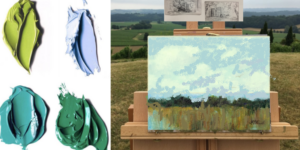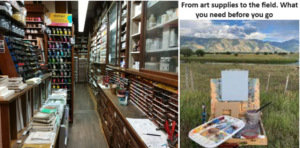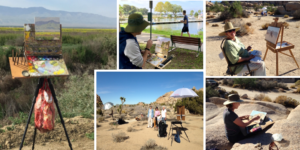-
- “Everything that is painted directly and on the spot has always a strength, a power, a vivacity of touch which one cannot recover in the studio… three strokes of a brush in front of nature are worth more than two days of work at the easel.” Eugene Boudin
This summer TheArtGuide.com staff turned its attention to the American Southwest visiting art museums and galleries of a geographic and cultural area first colonized by Indian, Spanish, and Mexican settlers. Social influences of the region encouraged years of unique American artwork that continue today in the practices of local art communities.
During their travel, Art Guide’s field team was invited to join a group of New Mexico plein air artists. Unplanned, but ready for an art adventure they agreed, quickly gathered paint supplies and sun block for a shared moment with the locals. Their goal was a brief painting excursion to capture the special light of a western landscape. For readers unfamiliar to the area, southern US has a quality of pure radiant sunlight that’s captivating, but a challenge to recreate on canvas. By its own terms, painting on location is inherently unruly; dependent on paint medium, weather, unexpected wild life (a snake) and wind conditions. Our team had the good fortunate of a sunny day, and ended their plein air work with a few mini masterpieces. In this article they share a few basic outdoor painting tips.
“Working in nature is singular and immediate, the experience will help with later home studio work focus and speed.”

Historically, ‘en plein air,’ in the open air, painting dates back to British artist John Constable (1776-1837), who was the first to store pre-mixed paint in pigs’ bladders for field work. On location, he’d set up a large blank “six-footer” canvas that no doubt acted like a kite in windy conditions. Shortly later, in 1841 this practice improved by the advent of metal paint tubes that made oil painting more versatile and freed landscape artists for work directly in nature. Though Constable never left England, French art dealer John Arrowsmith submitted three of his landscapes to the 1824 Paris Art Salon. Constable’s painting “The Hay Wain” was singled out for a prominent gold medal awarded by King Charles X of France. Recognized by professionals of the time, his work was an innovative approach in showing realistic weather conditions and the latent atmosphere between distant distant objects. His outdoor painting technique reverberated throughout France, inspiring the French Barbizon Art school and later Impressionist movement. Constable had begun a new standard in an experimental art genre that inspires artists today.
Following in Constable’s noble tradition, the Art Guide staff found that painting on location is a challenge that offers the reward of time well spent in nature with a community of likeminded artists. During the summer months, they’d like to encourage our readers to leave the comfort of an indoor studio for an unpredictable experience of working in nature. To help plan an excursion, Art Guide offers suggestions, from preparing a color palette to testing different landscape compositions and using portable art materials.
Travel Paint Supplies
Easel: If you’re starting out, a simple wood tri-pod easel, is least expensive, but slightly heavier than a metal easel. However, an unexpected benefit of the heavier wood easel is that it’s more stable in wind. Conventional field easel or box easels work like a suitcase that can easily compact paints, brushes and general supplies.
Paints: Entirely your choice, but a simple go-to option is watercolor and paper block or acrylics that dry quickly and can be cleaned with water. Mastering oil paint in nature takes dedication and practice, but is a rewarding experience that can best express atmosphere. If you’d like to create completed works in oil, remember the slow dry time and include a box container to hold the canvas stable during travel.
Brushes and Palette: A simple paper tear-off palette is disposable and works well with just a few favorite brushes.
Canvas: The trend now is to use watercolor blocks of paper, small panels or canvas boards as they offer a solid paint surface and are super portable. The new Oil and Acrylic paper pads are light weight and convenient during hikes. Plan your support size, based on focal point and location of drawing edges.
Plastic bag: Paper towels and plastic bag are essential in clean up and trash removal. Per the Boy Scout motto, ‘take only pictures, leave only footprints.’

Getting Started
Artists generally initiate outdoor painting projects by reducing a vast scenery of options to one composition, which is not always easy. In starting, our team’s recommendation is to keep a design plan and materials simple. Purchasing a variety of modern-day art equipment is costly and once in the field, often ignored in lieu of a simple compact watercolor kit with paper block. Reliable studio materials are a great help to avoid equipment distractions and enhance focus on the creative task at hand.
Thumbnail Sketches are the starting place for organizing a visual scenic expanse into a few brief line movements and isolate key compositional elements. At this stage, it’s important to envision perspective and layout by drawing a series of small vignettes for planning and later review.
With just a sketchbook and a few soft grade pencils in hand, it’s a good idea to walk about an area looking for inspiration. It will happen, and a chance to gather visual ques. Do hesitate, do stop, to draw a quick sketch and then move on. At this point there is no commitment only pictural notes. Use that time to also move objects about your picture plain and collect a diary of information that won’t be lost to a new bit of scenery at the next turn in your path. Sketched notes are a vital field reference and should include a range of directional pencil marks, that can later resemble brush strokes to differentiate textures, such as a grassy wheat field vs water or a jagged rock face.
-
- “With all the changing atmosphere and clouds, light and everything, you basically have to stick to your original idea. It’s very challenging at times.” Clyde Aspevig
Basic shapes: By using large brush movement and working an entire paint surface, field drawings can then act as a map for design transfer to canvas. Block in key elements, while mindful of composition and eye movement from foreground to diffused background objects. Avoid painting hard edges or getting tied to any detail at this stage. Once complete, wash in objects tonal values, light and dark areas will create balance that will move a viewer’s eye across the final work.
Be mindful of all the shadows! Good shadow placement validates a landscape and adds volume to a setting; however, the sun’s movement will change a scenic view in an instant. Work quickly, commit to shadow length and direction, then ignore the sun’s persistence to change your plan. Shadow value is achieved by using a surrounding paint color with a graduated mix of its complement.
Winslow Homer once visited Monet in Giverny to find, “Monet pulled out his latest series, views, at differing hours and weather, of the river, announcing the full significance of summer, sun, heat, and quiet on the reedy shore. The pictures were flowing in treatment, pointillism was in suspension; at least were the subjects.” A visit with Claude Monet, from the diary of Cecilia Beaux. – It’s interesting to note the least significant were actual land objects, in lieu of atmosphere.

Stay Committed/End Strong
Once a canvas design has blocked in massing of shapes, shadow and value, it’s time to focus in on the tighter elements of texture and specific color. This is the awaited for moment that first inspires one to a space of scenery. It is this stage that perspective, atmospheric color and value enter the creative process of refinement or exaggeration of elements, of the completed work.
After their day in the field, our Art Guide travel team felt that the New Mexico painting adventure was rewarding. Working directly in nature offered a nearness and singular focus to their paintings. The crew also agreed that the experience will later add speed and organization to in-house studio work. However, not all of the en plein air paintings were finished on location that day. Their sketchbooks will now act as excellent reference for in-studio work to be completed at a later time, possibly with new insight.
-
- “Ninety percent of my plein-air landscape paintings are completed on location, but it’s the last ten percent that I do at my studio easel that is my personal interpretation as an artist.” Peter Adams, art instructor



